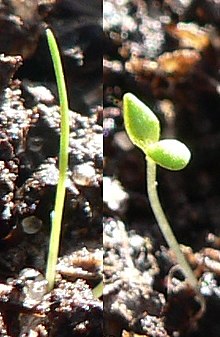**Cotyledon Characteristics:**
– Cotyledon is a vital part of the embryo in seed-bearing plants.
– Botanists use the number of cotyledons to classify flowering plants.
– Dicotyledonous plants have two embryonic leaves, while monocotyledonous plants have one.
– Cotyledons can be photosynthetic in dicots but are developmentally distinct from true leaves.
– Gymnosperms also have cotyledons, with varying numbers depending on the species.
**Cotyledon Structure:**
– In grasses and monocots, the cotyledon is a modified leaf with a scutellum and coleoptile.
– Gymnosperms like conifers have variable numbers of cotyledons.
– Cotyledons can be ephemeral or persistent, storing food reserves for the seedling.
– As reserves deplete, cotyledons may turn green and start photosynthesis.
– Cotyledons play a crucial role in the early growth stages of plants.
**Epigeal vs. Hypogeal Development:**
– Cotyledons can be epigeal, emerging above ground and becoming photosynthetic.
– Hypogeal cotyledons remain below ground and act as storage organs.
– Hypogeal plants generally have larger seeds than epigeal plants.
– Some plants exhibit a mix of hypogeal and epigeal development.
– The cotyledon’s role in seed germination impacts the plant’s survival strategy.
**History of Cotyledon Term:**
– Marcello Malpighi coined the term ‘cotyledon.’
– John Ray was the first to recognize the significance of cotyledon numbers in plant systematics.
– The distinction between dicots and monocots may have been recognized by Theophrastus and Albertus Magnus.
– Linnaeus also made contributions to the understanding of cotyledons.
– The term ‘cotyledon’ has a rich history in botanical literature.
**Notes, References, and External Links:**
– The Oxford English Dictionary attributes the term ‘cotyledon’ to Linnaeus.
– Various studies and publications have explored seedling development and cotyledon functions.
– Botanical history texts and research papers provide insights into the evolution of botanical terms.
– Understanding the etymology and historical context of ‘cotyledon’ enriches botanical knowledge.
– References to seminal works and researchers in the field of botany shed light on the significance of cotyledons in plant biology.
A cotyledon (/ˌkɒtɪˈliːdən/; lit. 'seed leaf'; from Latin cotyledon; from κοτυληδών (kotulēdṓn), gen. κοτυληδόνος (kotulēdónos), from κοτύλη (kotýlē) 'cup, bowl') is a significant part of the embryo within the seed of a plant, and is defined as "the embryonic leaf in seed-bearing plants, one or more of which are the first to appear from a germinating seed." The number of cotyledons present is one characteristic used by botanists to classify the flowering plants (angiosperms). Species with one cotyledon are called monocotyledonous ("monocots"). Plants with two embryonic leaves are termed dicotyledonous ("dicots").






In the case of dicot seedlings whose cotyledons are photosynthetic, the cotyledons are functionally similar to leaves. However, true leaves and cotyledons are developmentally distinct. Cotyledons are formed during embryogenesis, along with the root and shoot meristems, and are therefore present in the seed prior to germination. True leaves, however, are formed post-embryonically (i.e. after germination) from the shoot apical meristem, which is responsible for generating subsequent aerial portions of the plant.
The cotyledon of grasses and many other monocotyledons is a highly modified leaf composed of a scutellum and a coleoptile. The scutellum is a tissue within the seed that is specialized to absorb stored food from the adjacent endosperm. The coleoptile is a protective cap that covers the plumule (precursor to the stem and leaves of the plant).
Gymnosperm seedlings also have cotyledons. Gnetophytes, cycads, and ginkgos all have 2, whereas in conifers they are often variable in number (multicotyledonous), with 2–24 cotyledons forming a whorl at the top of the hypocotyl (the embryonic stem) surrounding the plumule. Within each species, there is often still some variation in cotyledon numbers, e.g. Monterey pine (Pinus radiata) seedlings have 5–9, and Jeffrey pine (Pinus jeffreyi) 7–13 (Mirov 1967), but other species are more fixed, with e.g. Mediterranean cypress always having just two cotyledons. The highest number reported is for big-cone pinyon (Pinus maximartinezii), with 24 (Farjon & Styles 1997).
Cotyledons may be ephemeral, lasting only days after emergence, or persistent, enduring at least a year on the plant. The cotyledons contain (or in the case of gymnosperms and monocotyledons, have access to) the stored food reserves of the seed. As these reserves are used up, the cotyledons may turn green and begin photosynthesis, or may wither as the first true leaves take over food production for the seedling.
